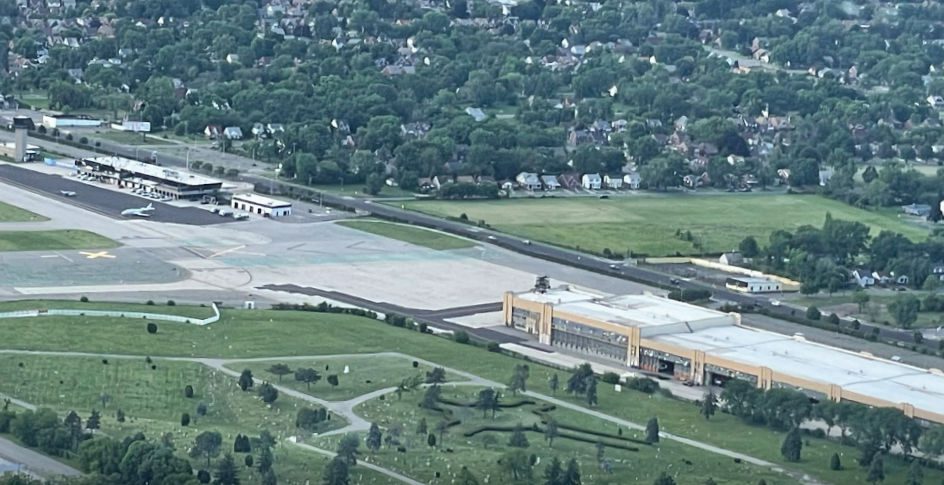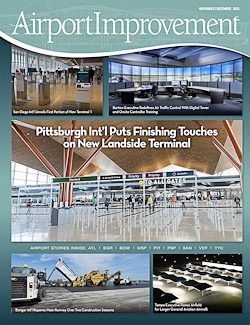With crumbling infrastructure, cemeteries on three sides and its Airport Layout Plan lying dormant for decades, Coleman A. Young Municipal Airport (DET) in Detroit had pretty much been left for dead. Lately, however, there are promising signs of a resurrection thanks to local support and up to $70 million in federal funding and $4 million in state support for improvements over the next 10 years.
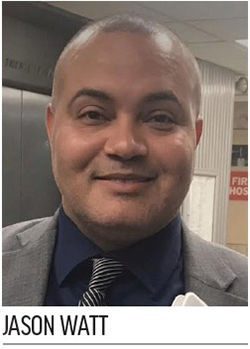 Just two years after Jason Watt was hired as director of the city-owned airport, Detroit declared bankruptcy. Not surprisingly, plans to modernize, or even maintain, the airport were not priorities for beleaguered leaders desperate to find ways to cut and/or monetize the city’s holdings. As an enterprise fund facility, DET was considered expendable, and city officials wanted to explore alternative uses for the land it occupied.
Just two years after Jason Watt was hired as director of the city-owned airport, Detroit declared bankruptcy. Not surprisingly, plans to modernize, or even maintain, the airport were not priorities for beleaguered leaders desperate to find ways to cut and/or monetize the city’s holdings. As an enterprise fund facility, DET was considered expendable, and city officials wanted to explore alternative uses for the land it occupied.
Conversely, Watt saw great potential in DET because it is the closest airport to downtown Detroit and just 10 miles from the U.S./Canada border. The Detroit native just needed to convince the mayor and city council that DET could be a viable asset for the city, state and beyond. “The airport is an add-on feature to a thriving, robust city,” Watt explains. “I needed the city to get to a thriving robust phase for them to put the proper attention that was needed at the airport.”
 facts&figures facts&figures
Project: Redeveloping & Modernizing Facilities Unique Challenges: Decades of decline; city bankruptcy Location: Coleman A. Young Municipal Airport, Detroit, MI Owner/Operator: City of Detroit Size: 300 acres Age: 98 yrs. old Annual Operations: 60,000 Based Aircraft: 145 Airport Employees: 11 Key Milestone: Receiving FAA approval for Airport Layout Plan in 2022 Investment: $84 million for infrastructure improvements over 10 years Funding: 90% FAA, 5% state, 5% city Airport Study: Avion Solutions Group LLC Airport Consultant: Kimley-Horn Key Development: Airspace Experience Technologies is developing large-scale eVTOL aircraft onsite; 2 tenants (Avflight & MyFlight Tours) broke ground for multimillion-dollar facilities this year; Runway Safe is under contract to provide Engineered Materials Arresting Systems on both ends of primary runway in 2027; B.O. Davis Aerospace Technical High School will begin holding classes in remodeled passenger terminal in 2027 |
Building Coalitions and Consensus
When the city came out of bankruptcy in December 2014, Watt needed a solid team around him to keep the airport alive. Some employees left during the bankruptcy, which he describes in retrospect as an opportunity to hire new talent for the mission ahead.
Despite little to no financial investment in DET from the city, several private groups stepped up to help maintain operations at the airfield widely known as Detroit City Airport. Key supporters included the Friends of Detroit City Airport; Tuskegee Airmen National Museum; the local chapter of Black Pilots of America; and B.O. Davis Aerospace Technical High School, which was previously located at the airport but has maintained ties since it was moved in 2013.
Watt explains that he and the various groups have built very strong relationships during his 14 years as airport director. “Honestly, I feel like promises were made, and I’m going to deliver on those promises and make sure this airport will be everything it should have always been for the city,” he reflects.
In February 2016, Alex Gertsen, senior director of Airport Advocacy and Vertical Infrastructure for the National Business Aviation Association (NBAA), got a call from a flight department at DET regarding the city’s desire to close the airport and repurpose the land for non-aviation use. Knowing that Detroit’s mayor and other city politicians had to be persuaded against shuttering valuable aviation infrastructure that might never return, NBAA supported some quick coalition building that included the airport users, based tenants and the FAA.
As part of the coalition, an ad-hoc education association was formed, because education is a big focus of what was already happening at DET and an important part of the vision Watt and other supporters have for its future. The airport’s connections with B.O. Davis Aerospace Technical High School and the Tuskegee Airmen (the airport’s namesake, Coleman A. Young, was himself a Tuskegee Airman) helped win over some city council members, and facts about the airport’s economic benefits added objective data. There were also compelling legal arguments against closing DET associated with its obligations regarding certain land purchased with federal funds.
At the time, the airport’s main runway,15-33, was at the end of its 20-year lifecycle and needed an overlay. Although the city was still undecided about what to do with the property overall, Watt convinced the mayor to invest in DET after long discussions about airport infrastructure and moving forward with next-gen air mobility systems and other innovative technologies. After the $3.5 million city-funded runway overlay was completed in July 2017, the city was fully on board with revitalizing the airport, he relates.
Concept, Condemnation and Community
Watt credits councilman Scott Benson of District 3 for creating an airport task force on the City Council not only to shape the future of DET, but also to understand what airports do and what DET could do for the east side of Detroit. Task force meetings helped spread the word about developing the airport and garnered the community support necessary to make it happen, Watt explains.
In 2017, the city commissioned an extensive viability study of the airport by Avion Solutions Group LLC. One of the resulting recommendations was to decommission Secondary Runway 7-25 to open up 86 acres of airport property for future industrial development. The runway was, in fact, decommissioned in November 2024 and crews are removing all airfield pavements, etc. so the land can eventually qualify for non-aeronautical use.
Gertsen acknowledges the challenging nature of deciding to close one of DET’s runways, and shares the prevailing logic. At 3,700 feet, 7-25 would have had to be shortened significantly to meet FAA standards and would have lost its utility. As such, the land it occupies could provide more value to the airport if used for hangars; an aircraft maintenance, repair and overhaul shop; or the field’s fixed-base operator (FBO). One drawback, however, is that flight training is now impacted on days when winds are significant.
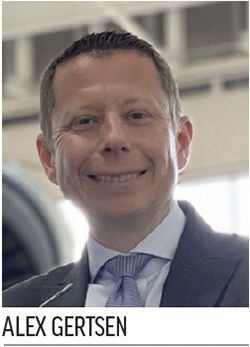
For decades, the FAA has required the city of Detroit to acquire property east of the airport to bring the airfield’s footprint into compliance with federal standards. Beginning in 1994, the city began acquiring 70 acres of land that included approximately 25 homes, a church and a playground that were too close to the runway centerline and necessary for airport expansion. Lack of funding and other delays halted progress until the effort resumed in 2022.
Watt notes that the Uniform Relocation Act was used to acquire properties through condemnation, and owners received just and fair compensation. In some cases, new homes were purchased. “I believe airports have to be good neighbors,” Watt emphasizes. “They felt like they had been forgotten, and it was an honor to tell them they weren’t.”
The property acquisition program is slated to end later this year.
Moving Forward
Completing an updated Airport Layout Plan was critical to securing grant money for the many infrastructure improvements that are needed.
 “City Airport had been chugging along any way that they could by paying out of pocket for maintenance and improvements,” explains Colin Wheeler, project manager for DET consultant Kimley-Horn. “That limited their ability to invest, and there really wasn’t a lot that had been invested since they lost commercial service in the early 2000s.”
“City Airport had been chugging along any way that they could by paying out of pocket for maintenance and improvements,” explains Colin Wheeler, project manager for DET consultant Kimley-Horn. “That limited their ability to invest, and there really wasn’t a lot that had been invested since they lost commercial service in the early 2000s.”
There were a few electronic records available to ready the Airport Layout Plan for approval, but flooding damaged or destroyed all physical records and drawings stored in the basement of the former terminal building. “A lot of information that would have been helpful for us was now not available,” Wheeler laments.
Nevertheless, he and Kimley-Horn gritted on, eventually securing conditional approval for the Airport Layout Plan from the FAA and Michigan Department of Transportation (MDOT) in July 2022. Achieving this huge milestone allowed DET to start focusing on grant-funded and other projects it wanted to pursue.
The initial challenge for Wheeler was understanding the 98-year-old, 300-acre property. One major (and disheartening) discovery was that almost all major utilities for the entire east side of the city are buried around and adjacent to the airport.
Cemeteries located north and south of the primary runway were another key issue, and one of the main reasons DET could not secure standard approval for its Airport Layout Plan. The cemeteries are so close, the airport’s runway safety areas do not meet FAA standards.
At Wheeler’s behest, a subconsultant inquired about the cost of acquiring the property and learned that the cemetery to the north is one of the city’s oldest, and many prominent local figures are buried there. “Obviously, there is the political nightmare of digging up graves and relocating them and all the news that comes along with that, so it was kind of a non-starter,” Wheeler recalls.
However, through the Airport Layout Plan process and substantial coordination with both MDOT and FAA, the team concurred that installing an EMAS (Engineered Material Arresting System) on both ends of the runway would be a viable, effective way to move through those challenges. Runway Safe is under contract to supply the EMAS beds, with installation expected in 2027. Wheeler suspects that no other general aviation airport in Michigan has an EMAS and notes that MDOT provided invaluable guidance to justify and coordinate the specification.
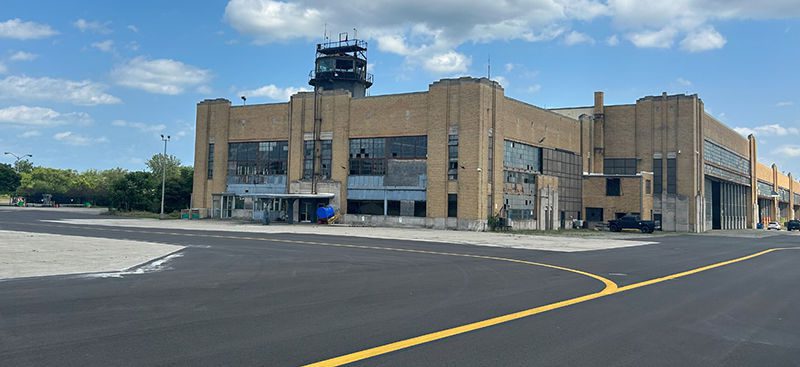
The historic Executive Terminal currently houses corporate aircraft and provides space for outreach programs sponsored by the local Tuskegee National Historical Museum.
With plans for the EMAS in place, FAA approved the airport’s 20-year Airport Layout Plan in September 2022 and is coordinating with DET to allocate about $9 million for the design and construction of the EMAS, with potentially tens of millions in additional funding beyond that project. Making the EMAS project a top priority was a key provision.
Watt emphasizes that DET will meet all FAA airport design criteria after the $9 million federally funded EMAS beds are installed. “And that will be probably the first time ever,” he muses. Preliminary design and environmental work for the project have already started. Construction is scheduled for spring to fall 2027.

Improving the main runway in 2017 was a key turning point for the airport.
Historic and Future Partnerships
Groundbreaking ceremonies for two multimillion-dollar tenant facilities are strong, visible signs of renewal at DET.
MyFlight Tours, a national helicopter tour operator, broke ground on its headquarters building this April. The Detroit company was founded in 2019 and expanded operations throughout the U.S., but decided to make DET its home base. The company’s new 12,000-square-foot facility is expected to open later this year, marking the airport’s first large-scale development in more than 50 years.
Gertsen, from NBAA, considers DET’s proximity to the city center a major factor in the company’s success providing popular and affordable tours in Detroit. “Reaching downtown by air takes only two minutes!” he emphasized after flying the tour route. “This provides city residents and visitors with an incredibly unique opportunity to take a seven-minute round-trip flight out of DET and to see the magnificence of Detroit from the air, while strengthening the value proposition of the historic airport.”
Avflight, the airport’s FBO, is also building a new facility at DET. After operating on short-term leases and working out of the old passenger terminal since 2011, the city rewarded the loyal FBO with a 30-year leasehold in May 2024. This June, Avflight promptly broke ground on a 5,000-square-foot terminal, 20,000-square-foot heated hangar, and an attached 1,440-square-foot parking garage.
Watt speaks highly of the airport’s 14-year relationship with Avflight. “They are very committed and willing to do just about whatever it takes to make sure this airport is successful. I couldn’t have done this without them,” he says, adding that Avflight was especially helpful during the city’s bankruptcy.
Joe Meszaros, vice president of Operations for Avflight, says the company is honored to play a leading role in revitalizing the airport with its recent investment. “We are committed to working hand-in-hand with the city and our partners to ensure DET continues to serve as a catalyst for economic growth and a source of pride for the community,” says Meszaros.
Vertical Flight and Emerging Tech
Watt is excited about the potential for eVTOL (electric vertical takeoff and landing) aircraft and other next-gen technologies to create an ecosystem that will help DET survive and thrive. He cites Airspace Experience Technologies, a company that has been developing large-scale, low-emissions eVTOL aircraft at the airport since 2017, as a key partner that is helping propel DET forward.
Despite this excitement, it’s not lost on Watt that Detroit is famous for manufacturing cars. He seems to reconcile his native pride in the Motor City by working to help it remain No. 1 in U.S. for mobility in general—cars or eVTOL. “That’s Detroit’s bread and butter,” he says. “The innovations we can do here at the airport will help us stay in that dominant space. We are committed, the entire city is committed, so that we don’t lose our place.”
Gertsen points out that being close to downtown will make DET a crucial asset for advanced air mobility operations, and foresees a bright future for the airport adding value to the city and region.
Various next-gen technologies developing at DET should dovetail nicely with educational initiatives being implemented at the airport.
Aviation Education Corridor
In 2023, DET was on the short list of locations for an eVTOL manufacturing plant but came in second despite offering approximately $285 million in financial incentives from the city of Detroit, the Michigan Economic Development Corporation and other stakeholders. Although the loss was devastating for the airport and city, Watt says it ultimately provided the opportunity to develop aviation and aerospace education locally, with an eye on expanding throughout southeastern Michigan and beyond.
Two initiatives are already in the works with Washtenaw and Wayne counties for high-level educational programming to help their youth become pilots, aviation maintenance technicians and even airport directors. Not yet willing to name names, Watt reports that he and city officials are negotiating with a very large aviation maintenance school about building a facility at DET.
In addition, B.O. Davis Aerospace Technical High School is returning to DET after being away for more than a decade and will be located in the airport’s former passenger terminal. The Detroit Public Schools Community District will pay $14.5 million to renovate the 60,000-square-foot facility into classrooms and hands-on environments for the specialty high school.
Watt says these education programs will help open the door for business development at the airport. “Essentially, it is my job is to make sure the community is utilizing their own airport,” he remarks. “This is what my community wanted for this airport, and it’s my job to figure out how to make all that work.”
The Tuskegee Airmen National Museum has had a long-term presence at DET and will continue to be an important player. In addition to providing scholarships, the group offers pilot training, maintenance training, drone instruction and other aviation-related courses to local youth at no cost.
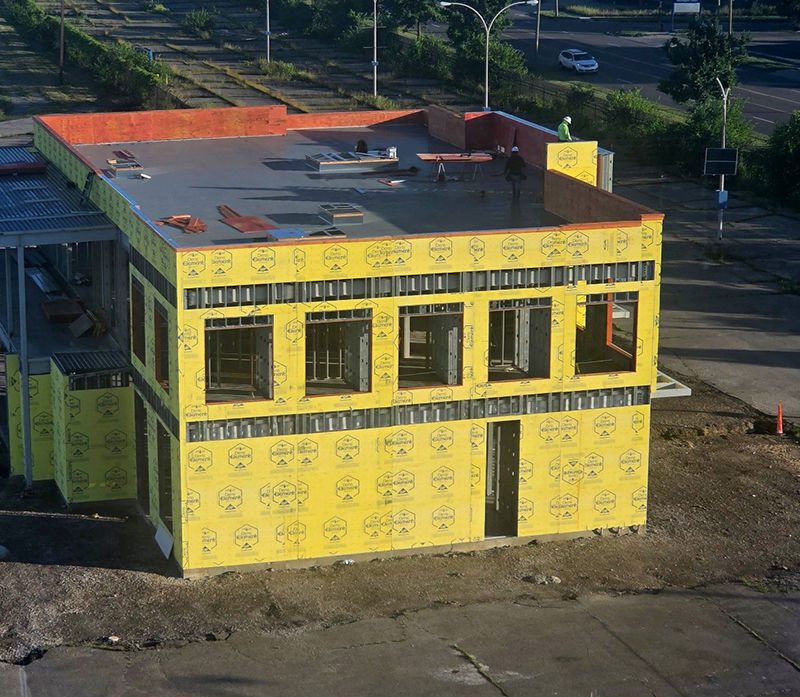
The facility currently under construction for MyFlight Tours is the first new vertical structure at the airport in more than 50 years.
The education component is personally significant for Watt because it provides workforce development and opportunities for Detroit youth. “I actually fell in love with aviation right here at this airport at 16 years old when I went up on a flight from a school now being refurbished,” he reminisces.
Phoenix Rising
Watt’s goal is to make DET a world-class business aviation airport and a good neighbor. His strategy is understanding what customers and the community want, and making money while providing it. The airport lost a lot of traffic to local competitors over the years, and he plans to win it back through revitalization.
“If you’re going to make a commitment to the community, you have to ride it out and deliver; and that takes time,” he reflects. “Just never give up. Follow through with commitments.”
Looking in from the outside, NBAA’s Gertsen is encouraged by the success building at DET. He credits Watt and the coalition that formed early on for helping the mayor and other key stakeholders recognize the immense value of aviation infrastructure and the bright future that investing in the airport will bring—connecting the city, providing education opportunities, jobs, innovation and growth.
Wheeler, from Kimley-Horn, has been surprised and heartened by hearing people in the industry speak about the airport in a positive light. “There is now hope and excitement regarding DET,” he remarks. “The right people are trying to do the right things for the airport and the city.”
Plenty of work remains for Watt and his staff of less than a dozen employees. “My airport is in the middle of a transformation, just as the city of Detroit is,” he says. “We will be like a phoenix rising.”
Ever the good ambassador, Watt welcomes all to come see how far the city and its growing general aviation airport have come. “It’s a beautiful city and I am ready to invite the world back,” he says warmly. “It’s been absolutely the most rewarding journey of my life. We’re having a lot of fun.”
In 2027, DET will celebrate its 100th anniversary with a gala—perhaps the perfect time for a visit.

